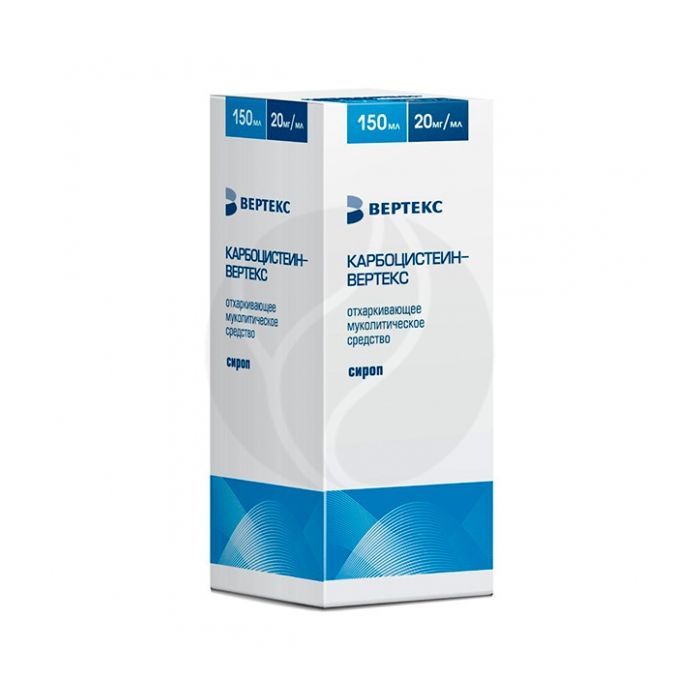Carbocisteine ??syrup 20mg / ml, 150ml
Expiration Date: 05/2027
Russian Pharmacy name:
Карбоцистеин сироп 20мг/мл, 150мл
Acute and chronic bronchopulmonary diseases and diseases of the ENT organs, accompanied by the formation of viscous, difficult to separate sputum (tracheitis, bronchitis, tracheobronchitis, bronchial asthma, bronchiectasis) and mucus (inflammatory diseases of the middle ear, nose and its paranasal sinuses - rhinitis, otitis media, sinusitis );
preparation of the patient for bronchoscopy or bronchography.
Inside.
Carbocisteine ??20 mg / ml:
One teaspoon of syrup (5 ml) contains 100 mg of carbocysteine.
Children aged 2-5 years: take 2 times a day, one teaspoon of syrup (200 mg per day);
Children over 5 years of age: Take 3 times a day, one teaspoonful (300 mg per day).
The syrup is in the form of a clear, colorless liquid, with a strawberry smell.
1 ml carbocisteine ??20 mg
Excipients: sucrose - 700 mg, flavor 'Strawberry with natural extract RX9711' - 1 mg, methyl parahydroxybenzoate (methylparaben) - 1.5 mg, sodium hydroxide - up to pH 6.1-6.3, purified water - up to 1 ml.
Hypersensitivity to carbocisteine;
peptic ulcer of the stomach and duodenum in the acute stage;
chronic glomerulonephritis (in the exacerbation phase);
cystitis;
pregnancy;
children's age - depending on the dosage form.
With care: history of gastric ulcer and duodenal ulcer; breastfeeding period; elderly patients; concomitant use of drugs that increase the risk of gastrointestinal bleeding.
pharmachologic effect
Mucolytic agent. The action is due to the activation of sialic transferase - an enzyme of the goblet cells of the bronchial mucosa. Normalizes the quantitative ratio of acidic and neutral sialomucins of bronchial secretions. Reduces the viscosity of bronchial secretions and discharge from the paranasal sinuses, facilitates the discharge of sputum and mucus, and reduces coughing. Promotes the regeneration of the mucous membrane, normalizes its structure, activates the activity of the ciliated epithelium. Restores the secretion of IgA immunoglobulin (specific protection) and the number of sulfhydryl groups of mucus components (non-specific protection), improves mucociliary clearance.
Pharmacokinetics
After oral administration, carbocisteine ??is rapidly absorbed. Low bioavailability (less than 10% of the dose taken). Cmax in blood serum and in the mucous membrane of the respiratory tract is achieved 2-3 hours after ingestion and remains in the mucous membrane for 8 hours. It is metabolized in the liver. It is excreted mainly by the kidneys, partly unchanged (30-60%), partly in the form of metabolites. T1 / 2 - about 2 hours
Side effect
From the digestive system: nausea, vomiting, diarrhea, epigastric pain, bleeding from the gastrointestinal tract.
From the immune system: allergic skin rash and anaphylactic reactions, including urticaria, angioedema, pruritus, exanthema, fixed drug rash.
Skin and subcutaneous tissue disorders: bullous dermatitis, Stevens-Johnson syndrome.
General reactions: dizziness, weakness, malaise.
Application during pregnancy and lactation
Contraindicated in pregnancy.
If necessary, use during lactation should decide on the termination of breastfeeding.
Application for impaired renal function
Contraindicated in chronic glomerulonephritis in the acute phase.
Application in children
It is possible to use in children according to indications, in doses and dosage forms recommended according to age. It is necessary to strictly follow the instructions in the instructions for carbocisteine ??preparations on contraindications for the use of specific dosage forms of carbocisteine ??in children of different ages.
Use in elderly patients
Use with caution in elderly patients.
special instructions
Care should be taken when using carbocisteine ??in elderly patients, with a history of gastric ulcer and duodenal ulcer, while taking drugs that increase the risk of gastrointestinal bleeding. With the development of gastrointestinal bleeding, you should stop taking carbocisteine.
Influence on the ability to drive vehicles and use mechanisms
During the period of treatment with carbocisteine, care should be taken when driving vehicles and when engaging in other potentially hazardous activities due to the possibility of dizziness and weakness.
Drug interactions
Carbocisteine ??increases the effectiveness of therapy with GCS and antibacterial drugs in the treatment of infectious and inflammatory diseases of the upper and lower respiratory tract.
Carbocisteine ??potentiates the bronchodilator effect of theophylline.
The action of carbocisteine ??is weakened by antitussives and m-anticholinergics.

